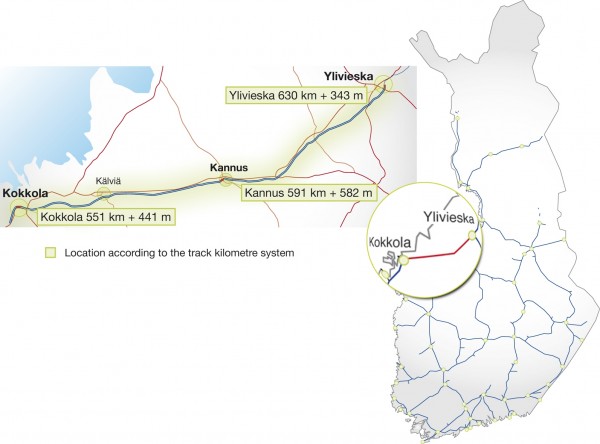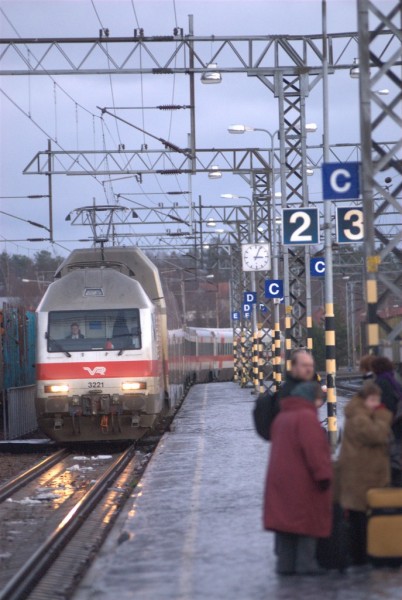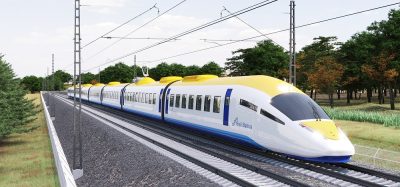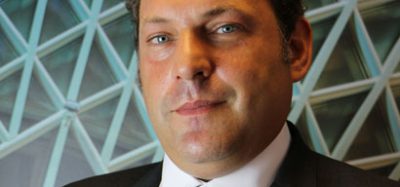Public Private Partnership to be used in a Finnish second track project
Posted: 31 May 2010 | | No comments yet
In a large-scale project of the Finnish Transport Agency, a 76.5km second track will be built between Kokkola and Ylivieska. To fund the project, a Public Private Partnership will be used for the first time in the Finnish railway network. It is also desirable to have foreign competitors for the challenging project. The total construction cost is €263 million.
The Finnish Transport Agency is carrying out a unique railway project in Finland. Between 2011 and 2014, a second track will be built between the cities of Kokkola and Ylivieska. Its total length will be 76.5 kilometres. At the same time, the existing track will be renewed.
In a large-scale project of the Finnish Transport Agency, a 76.5km second track will be built between Kokkola and Ylivieska. To fund the project, a Public Private Partnership will be used for the first time in the Finnish railway network. It is also desirable to have foreign competitors for the challenging project. The total construction cost is €263 million. The Finnish Transport Agency is carrying out a unique railway project in Finland. Between 2011 and 2014, a second track will be built between the cities of Kokkola and Ylivieska. Its total length will be 76.5 kilometres. At the same time, the existing track will be renewed.
In a large-scale project of the Finnish Transport Agency, a 76.5km second track will be built between Kokkola and Ylivieska. To fund the project, a Public Private Partnership will be used for the first time in the Finnish railway network. It is also desirable to have foreign competitors for the challenging project. The total construction cost is €263 million.
The Finnish Transport Agency is carrying out a unique railway project in Finland. Between 2011 and 2014, a second track will be built between the cities of Kokkola and Ylivieska. Its total length will be 76.5 kilometres. At the same time, the existing track will be renewed. The project is part of the upgrading of the Seinäjoki–Oulu line section. CC Infra Oy acts as the technical expert on the project. The second track between Kokkola and Ylivieska is one of the biggest railway projects in Finland in recent years, both as a construction project and in money terms. The second track will be the longest continuous second track ever built in Finland. Before this, the longest second track is 12km-long. Generally, second tracks are rare in the Finnish railways, since over 80% of the railway network is single-track. Unique in this project is also the funding model. The Kokkola–Ylivieska project will be implemented using a Public Private Partnership (PPP) model for the first time in Finland´s rail network. In doing so, the Finnish Transport Agency is acting as a trend-setter by creating and applying the new kind of funding model.
Capacity and safety will be improved
The construction area is part of the Seinäjoki–Oulu line section. It is a busy singletrack passenger and freight line that is used by most of the long-distance trains travelling between northern and southern Finland. The track is electrified, has an interlocking system and is remote-controlled, and an access control system was introduced in 2001. Approximately 50 trains use the line section on a daily basis.
The planning area is approximately 79km-long and a second track with a length of about 76km will be constructed in this area. The existing track will also be renewed and all the level crossings will be eliminated.
The project will have many significant impacts. First of all, the second track will remarkably improve the capacity of the busy line section. Now the maximum speed on the Kokkola–Ylivieska line section in passenger traffic is 140km/h. Thanks to the second track, the maximum speed can be raised to 160–200km/h, depending on the type of train.
The capacity of freight traffic will also be improved. Now the maximum axle load is 22.5 tonnes. With the second track, axle loads can be raised to 25 tonnes at 80–100km/h. This is significant, since the amount of traffic in the line section will increase due to mining projects, the concentration of the woodworking and paper industries and the increase in fast freight train services. Thanks to the second track, the competitiveness of freight traffic will be improved and more and more traffic can be shifted to the railways.


A second track with a length of approximately 76.5km will be constructed between Kokkola and Ylivieska in 2011–2014
The project also has many other objectives. With the second track, sensitivity to disturbances in freight and passenger traffic will be significantly reduced. Journey times in northern Finland will be shortened as a result of raising the maximum speed. In addition, safety will be improved thanks to the elimination of level crossings. From a wider point of view, the project will also have positive impacts on the environment. The second track will make it possible to increase the amount of trains. The more traffic moves to environmental friendly modes of transport, the better it is for global climate change.
Public Private Partnership pilot
Unique in this project is also the funding model. The Kokkola–Ylivieska project will be implemented using a Public Private Partnership (PPP) model for the first time in Finland´s rail network. In this model, in addition to planning and construction, the service provider is responsible for track maintenance and funding for a set period. In the Kokkola–Ylivieska project, the Finnish Transport Agency is looking to conclude a contract for 20–30 years.
The PPP model that will be used in the Kokkola–Ylivieska project is an application of the Public Private Partnership model used widely elsewhere in the world. As the name implies, the model is based on a partnership between the public and private sectors.
In this model, the service provider has a longer guarantee and liability period compared to traditional models. In addition to planning and construction, the service provider is also responsible for track maintenance. In the model, the Finnish Transport Agency purchases an entire service package. The rail capacity specified in this service package must be kept at an agreed quality level for the entire contract period.
The PPP model makes it possible to speed up the implementation of large-scale projects. The purchaser will pay the provider a service charge as soon as the agreed service is in operation. This encourages a speedy timetable for construction and the start of service. In a Public Private Partnership, the allocation of risks is controlled and optimised. In traditional models, the purchaser is mainly responsible for risks.
In the PPP model risks are allocated to the parties that are in the best position to manage them. This ensures the quality of work, since the service provider has an extra incentive to do a good job.
Wide competition
According to the master plan in 2006–2009, the construction costs of the Kokkola–Ylivieska project will total €263 million. The total value of the PPP contract (planning, constructing, funding and maintenance) is estimated to be €660 million.
In creating the funding model, the project has plotted all the possible challenges the line section may confront in the contract period of 20–30 years. These challenges include, for example, severe and varying weather conditions and changing regulations. The total contract value of €660 million also includes maintenance costs, since the track will have to be repaired and maintained during the long contract period.
On the other hand, the long contract period also makes it possible to stimulate interest in the project outside Finland´s borders.
The Finnish Transport Agency is hoping that competition will be as wide as possible both in quantity and in quality. The second track project and the PPP model open up possibilities to attract new actors alongside the traditional ones.
The Finnish Transport Agency has compiled a report on the actors with whom the Rail Department has previously cooperated in railway projects. This report is supposed to help new contractors as they enter the Finnish market and the new operational environment.
Procurement notices for the project will be published in May 2010 in the European public procurement journal, Tenders Electronic Daily (TED). The procurement schedule is relatively long and will last until June 2011. After that, planning and construction will start. The second track between Kokkola and Ylivieska is supposed to be ready by the end of 2014.
Big project, big challenges
The second track between Kokkola and Ylivieska is a big project, and its challenges relate to funding as well as the concrete construction of the track.
First of all, to organise the funding model and to create a suitable operational model in the current global financial situation is challenging. In addition, the project has practically started from zero with the PPP model, since there was no such model ready to be used. In financing this project, one will create a PPP model that best suits Finland, railway construction and this line section. In doing so, the Finnish Transport Agency will also create best practices for the PPP model.
Safety is another huge challenge in this project. Traffic on the existing track will mainly continue during the construction of the second track. It is extremely important that safety will in no circumstances be weakened or endangered.


Kokkola railway station – the construction area is part of a busy passenger and freight traffic line section
It should also be noted that the second track will not only have impacts in the area of Kokkola, Ylivieska, Seinäjoki and Oulu, but on the whole rail network in Finland. A certain capacity must be maintained in the line section during construction, since the line section is part of the Finnish rail network. It is not a separate section, which is built and then brought into play. Trains must also be able to circulate in the rail network during construction, and there are no possibilities for detours. Therefore, the service provider must operate on traffic’s terms.
About the Authors
Mikko Asikainen
Mikko Asikainen graduated from the Wärtsilä Institute of Technology as a Civil Engineer and has worked in several engineering positions at companies including Keypro, Nokia Networks and Nokia Corp. He has been a Project Manager at the Finnish Transport Agency since 2009.
Antti Haapalahti
After graduating from Oulu Institute of Technology as a Civil Engineer, Antti Haapalahti has worked in several engineering and project management positions for com – panies including VR-Track Ltd, Finnish Rail Administration and Pöyry. He has been a Project Manager and Partner at CC Infra Oy since 2008.







